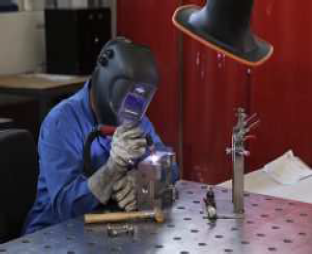TIG welding: 'clean' process with underestimated health risk
TIG welding is a popular technique for high-quality welding work, for example for pipes, furniture or art objects. Compared to MIG/MAG welding, it is significantly slower in practice, but creates a clean and uniform weld seam. A special feature of TIG welding is the use of a tungsten electrode that does not melt during the process. This creates only minimal weld splashes and generates relatively low amounts of weld fumes.
However, welders should not be fooled by the small amount of welding fumes: ozone and nitrous gases (nitrogen oxides) are generated during TIG welding. Ozone is classified as a carcinogen according to TRGS 905 [Reglas técnicas para sustancias peligrosas]. What. It's formed by UV radiation from oxygen in the air. UV radiation is generated by the arc: the greater the current, the greater the radiation. Ozone values are particularly high for aluminium-silicon alloys and pure aluminium. Since UV radiation goes beyond the immediate welding area, ozone is also generated outside the arc area and protective gases.
Watch the reflections
In addition, it is important not to underestimate the reflected rays. Black material such as iron or structural steel (e.g. S235JR+AR) is welded in metallurgical workshops. The ozone generated during welding decays more rapidly into smoke particles and other dust generated during MIG and MAG welding, for example during grinding. In addition, ozone radiation is absorbed more rapidly by the dark surfaces of workpieces made of black material. The situation is different for TIG welding: the workpieces processed in this process are usually made of aluminium or stainless steel. Their shiny metal surfaces reflect UV radiation, which means that ozone can form even at some distance from the weld site.
The reflections are also favored by the low smoke generation during TIG welding. The less smoke is generated, the more UV radiation can spread, which in turn leads to more ozone formation. In addition, ozone is an unstable gas: smoke or dust would promote its decomposition into oxygen, which is not the case if the development of smoke is low. Therefore, it is important not only to use point suction to capture particles in the form of welding fumes and ozone at the source. The ventilation of the support room prevents the spread of ozone in the factory room.
The electrode makes a difference.
 If a tungsten electrode is used that may contain thorium oxide during TIG welding, specifically when working with aluminium materials, then the welder is exposed to radioactive radiation due to smoke inhalation. What. The intensity of radiation exposure depends on the welding procedure, i.e. whether it is done with DC or AC. In DC TIG welding, you may assume that the annual threshold value of 6 milliSievert (mSv) is not exceeded by inhaling thorium oxide. However, if welding is done with AC, for example when aluminium materials are used, the limit is likely to be exceeded.
If a tungsten electrode is used that may contain thorium oxide during TIG welding, specifically when working with aluminium materials, then the welder is exposed to radioactive radiation due to smoke inhalation. What. The intensity of radiation exposure depends on the welding procedure, i.e. whether it is done with DC or AC. In DC TIG welding, you may assume that the annual threshold value of 6 milliSievert (mSv) is not exceeded by inhaling thorium oxide. However, if welding is done with AC, for example when aluminium materials are used, the limit is likely to be exceeded.
The result can be damage to the periosteum, bone marrow, liver and lung. In general, we recommend avoiding tungsten electrodes containing thorium oxide and using equivalent additives such as cerium or lanthanum. If this is not possible for technical reasons, then extraction at the source with filter devices tested by IFA (W3) is required or if the electrodes are rectified with dust collectors of class H1 (see BGI 746).
Last but not least, there is a danger due to dangerous carcinogens during TIG welding, as chromium-nickel steel is frequently welded by this process. This produces nickel oxide and chromium (VI) compounds, which can irritate the respiratory tract and damage the nervous system. Therefore, it is effective protection at work through the use of powerful extraction systems and filtration devices.




